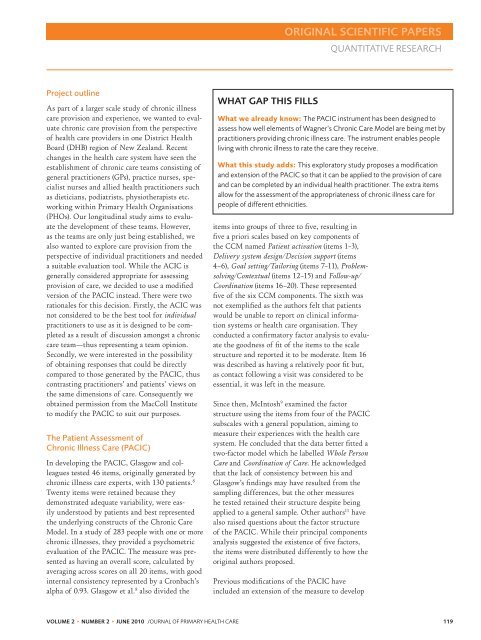entire issue - The Royal New Zealand College of General Practitioners
entire issue - The Royal New Zealand College of General Practitioners
entire issue - The Royal New Zealand College of General Practitioners
You also want an ePaper? Increase the reach of your titles
YUMPU automatically turns print PDFs into web optimized ePapers that Google loves.
ORIGINAL SCIENTIFIC PAPErS<br />
quantitative research<br />
Project outline<br />
As part <strong>of</strong> a larger scale study <strong>of</strong> chronic illness<br />
care provision and experience, we wanted to evaluate<br />
chronic care provision from the perspective<br />
<strong>of</strong> health care providers in one District Health<br />
Board (DHB) region <strong>of</strong> <strong>New</strong> <strong>Zealand</strong>. Recent<br />
changes in the health care system have seen the<br />
establishment <strong>of</strong> chronic care teams consisting <strong>of</strong><br />
general practitioners (GPs), practice nurses, specialist<br />
nurses and allied health practitioners such<br />
as dieticians, podiatrists, physiotherapists etc.<br />
working within Primary Health Organisations<br />
(PHOs). Our longitudinal study aims to evaluate<br />
the development <strong>of</strong> these teams. However,<br />
as the teams are only just being established, we<br />
also wanted to explore care provision from the<br />
perspective <strong>of</strong> individual practitioners and needed<br />
a suitable evaluation tool. While the ACIC is<br />
generally considered appropriate for assessing<br />
provision <strong>of</strong> care, we decided to use a modified<br />
version <strong>of</strong> the PACIC instead. <strong>The</strong>re were two<br />
rationales for this decision. Firstly, the ACIC was<br />
not considered to be the best tool for individual<br />
practitioners to use as it is designed to be completed<br />
as a result <strong>of</strong> discussion amongst a chronic<br />
care team—thus representing a team opinion.<br />
Secondly, we were interested in the possibility<br />
<strong>of</strong> obtaining responses that could be directly<br />
compared to those generated by the PACIC, thus<br />
contrasting practitioners’ and patients’ views on<br />
the same dimensions <strong>of</strong> care. Consequently we<br />
obtained permission from the MacColl Institute<br />
to modify the PACIC to suit our purposes.<br />
<strong>The</strong> Patient Assessment <strong>of</strong><br />
Chronic Illness Care (PACIC)<br />
In developing the PACIC, Glasgow and colleagues<br />
tested 46 items, originally generated by<br />
chronic illness care experts, with 130 patients. 8<br />
Twenty items were retained because they<br />
demonstrated adequate variability, were easily<br />
understood by patients and best represented<br />
the underlying constructs <strong>of</strong> the Chronic Care<br />
Model. In a study <strong>of</strong> 283 people with one or more<br />
chronic illnesses, they provided a psychometric<br />
evaluation <strong>of</strong> the PACIC. <strong>The</strong> measure was presented<br />
as having an overall score, calculated by<br />
averaging across scores on all 20 items, with good<br />
internal consistency represented by a Cronbach’s<br />
alpha <strong>of</strong> 0.93. Glasgow et al. 8 also divided the<br />
WHAT GAP THIS FILLS<br />
What we already know: <strong>The</strong> PACIC instrument has been designed to<br />
assess how well elements <strong>of</strong> Wagner’s Chronic Care Model are being met by<br />
practitioners providing chronic illness care. <strong>The</strong> instrument enables people<br />
living with chronic illness to rate the care they receive.<br />
What this study adds: This exploratory study proposes a modification<br />
and extension <strong>of</strong> the PACIC so that it can be applied to the provision <strong>of</strong> care<br />
and can be completed by an individual health practitioner. <strong>The</strong> extra items<br />
allow for the assessment <strong>of</strong> the appropriateness <strong>of</strong> chronic illness care for<br />
people <strong>of</strong> different ethnicities.<br />
items into groups <strong>of</strong> three to five, resulting in<br />
five a priori scales based on key components <strong>of</strong><br />
the CCM named Patient activation (items 1–3),<br />
Delivery system design/Decision support (items<br />
4–6), Goal setting/Tailoring (items 7–11), Problemsolving/Contextual<br />
(items 12–15) and Follow-up/<br />
Coordination (items 16–20). <strong>The</strong>se represented<br />
five <strong>of</strong> the six CCM components. <strong>The</strong> sixth was<br />
not exemplified as the authors felt that patients<br />
would be unable to report on clinical information<br />
systems or health care organisation. <strong>The</strong>y<br />
conducted a confirmatory factor analysis to evaluate<br />
the goodness <strong>of</strong> fit <strong>of</strong> the items to the scale<br />
structure and reported it to be moderate. Item 16<br />
was described as having a relatively poor fit but,<br />
as contact following a visit was considered to be<br />
essential, it was left in the measure.<br />
Since then, McIntosh 9 examined the factor<br />
structure using the items from four <strong>of</strong> the PACIC<br />
subscales with a general population, aiming to<br />
measure their experiences with the health care<br />
system. He concluded that the data better fitted a<br />
two-factor model which he labelled Whole Person<br />
Care and Coordination <strong>of</strong> Care. He acknowledged<br />
that the lack <strong>of</strong> consistency between his and<br />
Glasgow’s findings may have resulted from the<br />
sampling differences, but the other measures<br />
he tested retained their structure despite being<br />
applied to a general sample. Other authors 11 have<br />
also raised questions about the factor structure<br />
<strong>of</strong> the PACIC. While their principal components<br />
analysis suggested the existence <strong>of</strong> five factors,<br />
the items were distributed differently to how the<br />
original authors proposed.<br />
Previous modifications <strong>of</strong> the PACIC have<br />
included an extension <strong>of</strong> the measure to develop<br />
VOLUME 2 • NUMBER 2 • JUNE 2010 J OURNAL OF PRIMARY HEALTH CARE 119

















